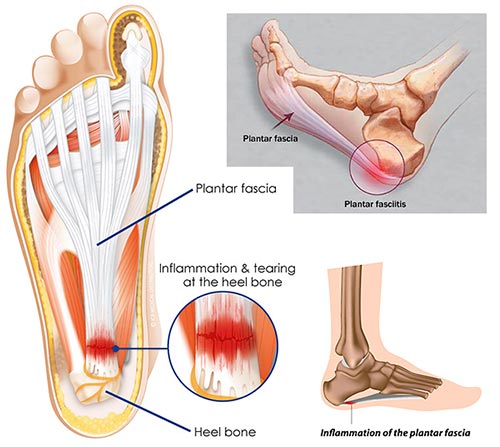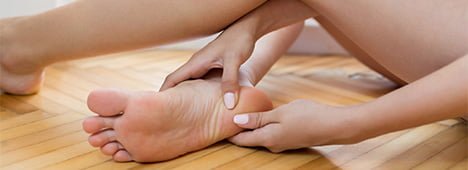Heel Pain

Heel pain is one of the most common foot problems among patients seen regularly by podiatrist in NYC. If you are experiencing heel pain, the pain is often beneath your heel. The reason the bottom of the heel commonly becomes painful is due to its attachment to a band of tough tissue, referred to as the plantar fascia. This band of tissue runs from your heel to the bottom of your forefoot and provides arch support. Plantar fasciitis is a medical condition when you have inflammation of this connective tissue.
All symptoms should always be evaluated with a thorough consultation and examination by your podiatrist for an accurate diagnosis and treatment plan to exclude any underlying serious condition. The other common heel issue is caused by the Achilles tendon, which typically causes pain on the back of the heel bone. The Achilles tendon is the major tendon that connects your lower leg to the back of your heel. It can get inflamed or from bone spurs if it is tight and becomes painful.
Playing Through Heel Pain
Heel pain can become disabling if not diagnosed and treated properly by a leading foot doctor in Manhattan. The best Manhattan podiatrist, our Podiatrists, warn that if you try to live with heel pain, you may end up with other foot and joint problems. This can happen because we alter the way we walk when we have heel pain causing strain on other areas of the body.
Of the 26 bones in your foot, the heel bone (called the calcaneus) is the largest. The heel functions to give support to the weight of your body. When you run, walk or jump, your heel absorbs the impact of the foot coming into contact with the ground. Thus it is important to ensure your heel is healthy and pain-free.
”
★ ★ ★ ★ ★A personable doctor who explained the problem simply and precisely. No wait, full attention to my concerns and questions, and just an overall great experience.
Heel Pain Causes

The pull of your plantar fascia and Achilles tendon are the most common causes of heel pain. Other causes include a stress fracture, cyst, tumor, or foot deformity. This is why an x-Ray is so important when diagnosing heel pain. Heel pain may also be caused by an infection, arthritis, autoimmune problems, or other systemic issues. Heel pain is usually caused by repetitive stress over time rather than a distinct injury one can pinpoint.
Symptoms of Heel Pain
Heel pain rarely shows immediate symptoms but rather appears gradually with no sign of injury. Your foot doctor can explain the most likely causes in your situation. Symptoms are often triggered by walking barefoot on hard surfaces or wearing flat shoes or sandals, and you can expect your foot doctor to instruct you on the best shoes to avoid having pain.
Flat footwear stretches out the plantar fascia tissues to the point that they become sore and swollen. When your pain is centered beneath your foot, near the front part of your heel, the cause is likely plantar fasciitis.
The condition where your feet hurt after rest is known as post-static dyskinesia. If you have heel pain, you’ll probably feel this when you get up and walk for the first time in the morning or when you stand after extended periods of rest during the day.
When you visit a foot specialist at Podiatry in New York, describe the symptoms you may be feeling.
If you experience any of the following, schedule a visit with your foot doctor in NYC as soon as possible:
- Numbness or a tingling sensation in your heel
- Severe heel pain with inflammation
- Inability to bend your foot down
- Inability to walk normally
- Unable to stand on the back of your feet and shift your weight to your tip-toes
- Extended pain even when you aren’t walking or standing
- Heel pain that persists over a week
All symptoms should always be evaluated with a thorough consultation and examination by your podiatrist for an accurate diagnosis and treatment plan to exclude any underlying serious condition.
Diagnosing Heel Pain
When you visit a good NYC podiatrist, you have a thorough physical examination. You also have to answer questions about your heel pain, your past health issues, and any foot-related issues that a member of your family has had. Your doctor typically asks how much standing and walking you do on a typical day and what type of shoes you wear. This exam is usually sufficient for determining what’s causing your heel pain. You may have X-rays or an MRI for bone issues, such as a break or bone spurs in your heel. If you’re concerned about your heel issues and want the best care, do a diligent search for the best NYC podiatrist.
Treatment of Heel Pain
The overwhelming majority of people with heel pain get better within months with conservative procedures — methods that don’t require surgery or a radical therapy regimen.
Some of the conservative treatments your NYC foot doctor may recommend include:
- Corticosteroids: Man-made drugs that resemble natural anti-inflammatory hormones
- Physical therapy: Specialized therapy where you work with a professional therapist or are given therapy exercises to perform at home
- Night splints: A support that fits over your foot and calf to wear at night; it stretches your Achilles tendon and plantar fascia
- Orthotics: Support devices used to correct foot abnormalities and provide cradling and cushioning of the arch while it heals
If conservative methods don’t produce beneficial results after several months, your foot doctor may recommend these treatments:
- Shock wave therapy: Therapy using sound waves directed at the affected region to promote healing
- Surgery: Removal of the plantar fascia. This is the last resort method if nothing else has worked.
Treating heel bumps or bone spurs in your heel is slightly different. Heel bumps are swollen areas behind your heel. They’re typically relieved with a change to proper footwear, as well as the application of ice and compression.
Home Care
Leading NYC podiatrists recommend the options below if you cannot make it to a foot doctor.
- Rest: Avoid standing for long durations and walking or running on hard surfaces
- Ice: Put a wrapped ice pack or bag of frozen peas on your heel for about 15 minutes
- Footwear: Only wear proper-fitting footwear with good arch support
- Supports: Use foot and arch supports, as well as heel cups and wedges, for pain relief
Important Reminder: This information is only intended to provide guidance, not definitive medical advice. Please consult your foot doctor about your specific condition. Only a trained, experienced board-certified podiatrist or foot specialist can determine an accurate diagnosis and proper treatment.
Do you have any questions about Heel Pain treatment in NYC? Would you like to schedule an appointment with an internationally recognized, top NYC Podiatrists and foot doctors at Manhattan Foot Specialists? Please contact our office for a consultation.
Dr. Mohammad Rimawi has either authored or reviewed and approved this content. New York City Locations Manhattan Foot Specialists (Upper East Side) 983 Park Ave Ste 1D, New York 10028Manhattan Foot Specialists (Midtown) 56 W 45th St, Ste 802, New York 10036
Manhattan Foot Specialists (Union Square) 55 W 17th St Ste 102, New York 10011
Manhattan Foot Specialists (Financial District) 80 Maiden Lane, Ste 1204, New York 10038
